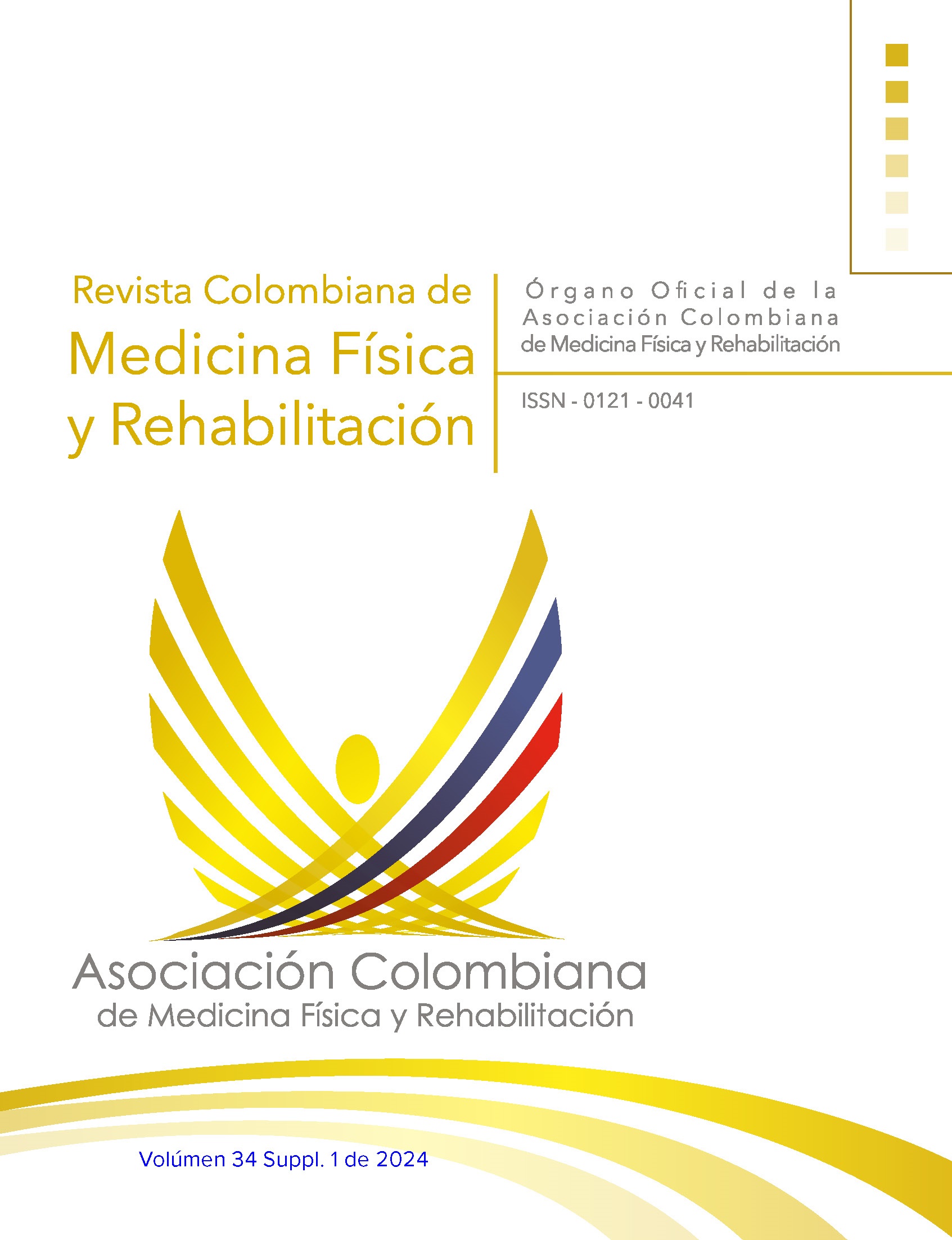Estrategias para la atención segura en rehabilitación de pacientes adultos con cáncer
DOI:
https://doi.org/10.28957/rcmfr.461Palabras clave:
Rehabilitación, seguridad, neoplasias malignas, citopeniaResumen
La seguridad del paciente es un principio fundamental en la atención en salud, el cual fue propuesto y desarrollado por la Organización Mundial de la Salud y busca disminuir los riesgos, reducir los daños evitables y mitigar el impacto en caso de producirse un daño. Gran parte de la información disponible sobre seguridad del paciente en rehabilitación oncológica se centra en la prescripción segura del ejercicio, la identificación de riesgos potenciales de acuerdo con el diagnóstico y las modalidades terapéuticas disponibles. Esta revisión narrativa tiene como objetivo brindar orientaciones prácticas para realizar intervenciones de rehabilitación seguras en adultos con cáncer que por sus condiciones hematológicas y óseas presentan un alto riesgo para eventos adversos. En la búsqueda de la literatura se halló que los eventos clínicos relacionados con conteos celulares e intervenciones terapéuticas fueron en su mayoría riesgo de sangrado, alteraciones musculares e infecciones. Para el caso de compromiso óseo en pacientes con cáncer, se encontró que este representa un factor de riesgo para la discapacidad relacionada con el movimiento derivada de eventos óseos como la hipercalcemia, las fracturas patológicas y los síndromes medulares malignos. Se recomienda que la atención de esta población sea orientada y llevada a cabo por profesionales y especialistas, tanto terapeutas como fisiatras, con formación específica en rehabilitación oncológica. La prescripción terapéutica de rehabilitación, incluyendo la movilidad temprana y segura, así como el ejercicio, parte de la verificación de factores de riesgo individuales; además, debe contemplar la comunicación clara dentro del equipo de rehabilitación, con el equipo de tratamiento oncológico, con la familia y con el paciente, así como el acceso y revisión de la historia clínica, los exámenes de laboratorio y las imágenes diagnósticas, cuyas interpretaciones deben estar sujetas a la condición clínica y funcional de los pacientes.
Biografía del autor/a
Anamaria Hernández-Rivera, Especialista en Rehabilitación Oncológica, convenio Universidad Militar Nueva Granada con el Instituto Nacional de Cancerología. Unidad funcional de cancerología Clínica SOMER
Farley Johanna González-Patiño, Master en Epidemiología universidad CES. Grupo de investigación en Epidemiologia y Bioestadística. Universidad CES
Referencias bibliográficas
Organización mundial de la salud. Proyecto de Plan de Acción Mundial para la Seguridad Del Paciente 2021-2030 Hacia la Eliminación de Los Daños Evitables en la Atención de Salud. Geneva: World Health Organization; 2023.
Espin S, Carter C, Janes N, McAllister M. Exploring Health Care Professionals’ Perceptions of Incidents and Incident Reporting in Rehabilitation Settings. J Patient Saf [Internet]. junio de 2019;15(2):154-60. Disponible en: https://journals.lww.com/01209203-201906000-00012
Coiera E, Collins S, Kuziemsky C. A unified model of patient safety (or «Who froze my cheese?»). BMJ [Internet]. 11 de diciembre de 2013; 347(dec11 1):f7273-f7273. Disponible en: https://www.bmj.com/lookup/doi/10.1136/bmj.f7273
Buttigieg SC, Tomaselli G, Von Eiff W, Byers V. Editorial: Patient Safety: Delivering Cost-Contained, High Quality, Person-Centered, and Safe Healthcare. Front Public Health [Internet]. 14 de julio de 2020; 8:288. Disponible en: https://www.frontiersin.org/article/10.3389/fpubh.2020.00288/full
Guía técnica "Buenas prácticas para la seguridad del paciente en la atención en salud" Versión 2.0. Paquete instruccional, Ministerio de salud y protección social. 2017.
Reason J. Human error: models and management. BMJ. 2000 Mar 18;320(7237):768-70. doi: 10.1136/bmj.320.7237.768. PMID: 10720363; PMCID: PMC1117770.
Organización Mundial de la Salud. Seguridad del paciente: Medidas mundiales en materia de seguridad del paciente1. Informe del Director General. 72.ª Asamblea Mundial de la Salud, 25 de marzo de 2019. Documento A72/26.
Rocco C, Garrido A. Seguridad del paciente y cultura de seguridad. Rev Médica Clínica Las Condes [Internet]. septiembre de 2017; 28(5):785-95. Disponible en: https://linkinghub.elsevier.com/retrieve/pii/S0716864017301268
Mello LRGD, Christovam BP, Moreira APA, Moraes EBD, Paes GO, Prates CG. Tools for the investigation of adverse events: scoping review. Rev Esc Enferm USP [Internet]. 2022; 56:e20210519. Disponible en: http://www.scielo.br/scielo.php?script=sci_arttext&pid=S0080-62342022000100802&tlng=en
11. Corrado B, Di Meglio C, Montuori P. Clinical risk in rehabilitation: an exploratory investigation in Campania Region. Ann Ig Med Prev E Comunità [Internet]. 30 de diciembre de 2014; (6):527-36. Disponible en: https://doi.org/10.7416/ai.2014.2011
Ten Tusscher MR, Groen WG, Geleijn E, Berkelaar D, Aaronson NK, Stuiver MM. Education Needs of Dutch Physical Therapists for the Treatment of Patients With Advanced Cancer: A Mixed Methods Study. Phys Ther [Internet]. 10 de marzo de 2020; 100(3):477-86. Disponible en: https://academic.oup.com/ptj/article/100/3/477/5729100
Mgobozi P, Mahomed OH. Epidemiology of patient safety incidents in a long-term rehabilitative hospital in KwaZulu-Natal, South Africa (April 2011 to March 2016). Curationis [Internet]. 18 de mayo de 2021; 44(1). Disponible en: http://www.curationis.org.za/index.php/curationis/article/view/2151
Hernández PM, Ordoñez LT, Guerrero JA. Evento adverso y seguridad del paciente en fisioterapia. Rev Cubana Investig Bioméd. 2021;40(4):e1192
Jesus TS, Papadimitriou C, Pinho CS, Hoenig H. Key Characteristics of Rehabilitation Quality Improvement Publications: Scoping Review From 2010 to 2016. Arch Phys Med Rehabil [Internet]. junio de 2018; 99(6):1141-1148.e4. Disponible en: https://linkinghub.elsevier.com/retrieve/pii/S0003999317311218
Montilla-Herrador J, Lozano-Meca JA, Baño-Alcaraz A, Lillo-Navarro C, Martín-San Agustín R, Gacto-Sánchez M. Knowledge and Attitudes towards Patient Safety among Students in Physical Therapy in Spain: A Longitudinal Study. Int J Environ Res Public Health [Internet]. 15 de septiembre de 2022; 19(18):11618. Disponible en: https://www.mdpi.com/1660-4601/19/18/11618
Guo M, Tardif G, Bayley M. Medical Safety Huddles in Rehabilitation: A Novel Patient Safety Strategy. Arch Phys Med Rehabil [Internet]. junio de 2018; 99(6):1217-9. Disponible en: https://linkinghub.elsevier.com/retrieve/pii/S0003999317312601
Scheirton L, Mu K, Lohman H. Occupational Therapists’ Responses to Practice Errors in Physical Rehabilitation Settings. Am J Occup Ther [Internet]. 1 de mayo de 2003; 57(3):307-14. Disponible en: https://research.aota.org/ajot/article/57/3/307/8564/Occupational-Therapists-Responses-to-Practice
Cristian A, Green J. Patient Safety and Quality Improvement in Rehabilitation Medicine. Phys Med Rehabil Clin N Am [Internet]. mayo de 2012; 23(2):221-30. Disponible en: https://linkinghub.elsevier.com/retrieve/pii/S1047965112000095
Leone RM, Adams RJ. Safety Standards: Implementing Fall Prevention Interventions and Sustaining Lower Fall Rates by Promoting the Culture of Safety on an Inpatient Rehabilitation Unit. Rehabil Nurs [Internet]. enero de 2016; 41(1):26-32. Disponible en: https://journals.lww.com/00006939-201601000-00004
Brathwaite D, Aziz F, Eakins C, Charles AJ, Cristian A. Safety Precautions in the Rehabilitation Medicine Prescription. Phys Med Rehabil Clin N Am [Internet]. mayo de 2012; 23(2):231-9. Disponible en: https://linkinghub.elsevier.com/retrieve/pii/S1047965112000101
Nydahl P, Sricharoenchai T, Chandra S, Kundt FS, Huang M, Fischill M, et al. Safety of Patient Mobilization and Rehabilitation in the Intensive Care Unit. Systematic Review with Meta-Analysis. Ann Am Thorac Soc [Internet]. mayo de 2017; 14(5):766-77. Disponible en: https://www.atsjournals.org/doi/10.1513/AnnalsATS.201611-843SR
Jomaa C, Dubois C, Caron I, Prud’Homme A. Staffing, teamwork and scope of practice: Analysis of the association with patient safety in the context of rehabilitation. J Adv Nurs [Internet]. julio de 2022; 78(7):2015-29. Disponible en: https://onlinelibrary.wiley.com/doi/10.1111/jan.15112
Raj VS, Pugh TM, Yaguda SI, Mitchell CH, Mullan SS, Garces NS. The Who, What, Why, When, Where, and How of Team-Based Interdisciplinary Cancer Rehabilitation. Semin Oncol Nurs [Internet]. febrero de 2020; 36(1):150974. Disponible en: https://linkinghub.elsevier.com/retrieve/pii/S0749208119301561
Maltser S, Cristian A, Silver JK, Morris GS, Stout NL. A Focused Review of Safety Considerations in Cancer Rehabilitation. PM&R [Internet]. septiembre de 2017; 9(9S2). Disponible en: https://onlinelibrary.wiley.com/doi/10.1016/j.pmrj.2017.08.403
Raj VS, Pugh TM. Inpatient cancer rehabilitation: past, present, and future perspectives. Curr Phys Med Rehabil Rep [Internet]. junio de 2018; 6(2):89-95. Disponible en: http://link.springer.com/10.1007/s40141-018-0179-8
Cristian A, Tran A, Patel K. Patient Safety in Cancer Rehabilitation. Phys Med Rehabil Clin N Am [Internet]. mayo de 2012; 23(2):441-56. Disponible en: https://linkinghub.elsevier.com/retrieve/pii/S104796511200023X
Chicharro, J. L., & Vaquero, A. Fisiología del ejercicio. 4a ed. Madrid: Editorial Médica Panamericana; 2023.
Bonilla Briceño Javier Fernando. Respuesta hematológica al ejercicio. Rev. Cienc. Salud [Internet]. 2005 Dec; 3( 2 ): 206-216. Available from: http://www.scielo.org.co/scielo.php?script=sci_arttext&pid=S1692-72732005000200009&lng=en.
Nielsen KA, George CLS, Gilchrist LS. Association Between Laboratory Values and Adverse Events in Adults Post-Hematopoietic Stem Cell Transplant During and After Rehabilitation. Arch Phys Med Rehabil [Internet]. septiembre de 2023; 104(9):1425-31. Disponible en: https://linkinghub.elsevier.com/retrieve/pii/S0003999323001612
Dimeo F, Fetscher S, Lange W, Mertelsmann R, Keul J. Effects of Aerobic Exercise on the Physical Performance and Incidence of Treatment-Related Complications After High-Dose Chemotherapy. Blood [Internet]. 1 de noviembre de 1997; 90(9):3390-4. Disponible en: https://ashpublications.org/blood/article/90/9/3390/139375/Effects-of-Aerobic-Exercise-on-the-Physical
Wiskemann J, Kleindienst N, Kuehl R, Dreger P, Schwerdtfeger R, Bohus M. Effects of physical exercise on survival after allogeneic stem cell transplantation. Int J Cancer [Internet]. diciembre de 2015; 137(11):2749-56. Disponible en: https://onlinelibrary.wiley.com/doi/10.1002/ijc.29633
Yang YP, Pan SJ, Qiu SL, Tung TH. Effects of physical exercise on the quality-of-life of patients with haematological malignancies and thrombocytopenia: A systematic review and meta-analysis. World J Clin Cases [Internet]. 6 de abril de 2022; 10(10):3143-55. Disponible en: https://www.wjgnet.com/2307-8960/full/v10/i10/3143.htm
AlJohi AA, Aljehani GH, AlSaeed SA, Alhoqail H, Mohammed J, Madi SM. Evidence-based exercises intervention in adults diagnosed with Lymphoma. Saudi Med J [Internet]. mayo de 2022; 43(5):441-50. Disponible en: https://smj.org.sa/lookup/doi/10.15537/smj.2022.43.5.20210894
Singh B, Hayes SC, Spence RR, Steele ML, Millet GY, Gergele L. Exercise and colorectal cancer: a systematic review and meta-analysis of exercise safety, feasibility and effectiveness. Int J Behav Nutr Phys Act [Internet]. diciembre de 2020; 17(1):122. Disponible en: https://ijbnpa.biomedcentral.com/articles/10.1186/s12966-020-01021-7
Jones LW, Alfano CM. Exercise-oncology research: Past, present, and future. Acta Oncol [Internet]. febrero de 2013; 52(2):195-215. Disponible en: http://www.tandfonline.com/doi/full/10.3109/0284186X.2012.742564
Neal J, Shahpar S, Spill G, Semik P, Marciniak C. Bleeding Events in Thrombocytopenic Patients With Cancer Undergoing Acute Rehabilitation. Rehabil Process Outcome [Internet]. 1 de enero de 2018; 7:117957271876137. Disponible en: http://journals.sagepub.com/doi/10.1177/1179572718761379
Fu JB, Tennison JM, Rutzen-Lopez IM, Silver JK, Morishita S, Dibaj SS, et al. Bleeding frequency and characteristics among hematologic malignancy inpatient rehabilitation patients with severe thrombocytopenia. Support Care Cancer [Internet]. septiembre de 2018; 26(9):3135-41. Disponible en: http://link.springer.com/10.1007/s00520-018-4160-y
Grencheski EA, Kochi MN, Politi FVA, Santos TMD, Brito CMMD, Yamaguti WP, et al. Bleeding frequency during physiotherapy in thrombocytopenic patients undergoing hematopoietic stem cell transplantation. Valdez BC, editor. PLOS ONE [Internet]. 30 de julio de 2021; 16(7):e0255413. Disponible en: https://dx.plos.org/10.1371/journal.pone.0255413
Thomsen SN, Lahart IM, Thomsen LM, Fridh MK, Larsen A, Mau-Sørensen M, et al. Harms of exercise training in patients with cancer undergoing systemic treatment: a systematic review and meta-analysis of published and unpublished controlled trials. eClinicalMedicine [Internet]. mayo de 2023; 59:101937. Disponible en: https://linkinghub.elsevier.com/retrieve/pii/S2589537023001141
U.S. Department of Health and Human Services. Common Terminology Criteria for Adverse Events (CTCAE) v5. Published: November 27, 2017. Common Terminology Criteria for Adverse Events (CTCAE) (cancer.gov)
Cattadori G, Agostoni P, Corrà U, Sinagra G, Veglia F, Salvioni E, et al. Heart failure and anemia: Effects on prognostic variables. Eur J Intern Med [Internet]. enero de 2017; 37:56-63. Disponible en: https://linkinghub.elsevier.com/retrieve/pii/S0953620516303120
Fioritto AP, Oliveira CC, Albuquerque VS, Almeida LB, Granger CL, Denehy L, et al. Individualized in-hospital exercise training program for people undergoing hematopoietic stem cell transplantation: a feasibility study. Disabil Rehabil [Internet]. 30 de enero de 2021; 43(3):386-92. Disponible en: https://www.tandfonline.com/doi/full/10.1080/09638288.2019.1626493
Hollenbach L, Rogahn J, Le Coutre P, Schulze S, Muegge LO, Geissler J, et al. Physical exercise recommendations for patients with chronic myeloid leukemia based on individual preferences identified in a large international patient survey study of the East German Study Group for Hematology and Oncology (OSHO #97). Front Oncol [Internet]. 21 de febrero de 2024; 14:1345050. Disponible en: https://www.frontiersin.org/articles/10.3389/fonc.2024.1345050/full
Jinbo R, Kasahara R, Morishita S, Kubota J, Takano A, Takahashi S, et al. Physical function, nutritional status, and quality of life before and after chemotherapy in patients with malignant lymphoma. Medicine (Baltimore) [Internet]. 10 de febrero de 2023; 102(6):e32901. Disponible en: https://journals.lww.com/10.1097/MD.0000000000032901
Morishita S, Nakano J, Fu JB, Tsuji T. Physical exercise is safe and feasible in thrombocytopenic patients with hematologic malignancies: a narrative review. Hematology [Internet]. 1 de enero de 2020; 25(1):95-100. Disponible en: https://www.tandfonline.com/doi/full/10.1080/16078454.2020.1730556
Fogarty PF, Tarantino MD, Brainsky A, Signorovitch J, Grotzinger KM. Selective validation of the WHO Bleeding Scale in patients with chronic immune thrombocytopenia. Curr Med Res Opin [Internet]. 1 de enero de 2012; 28(1):79-87. Disponible en: https://www.tandfonline.com/doi/full/10.1185/03007995.2011.644849
Webert KE, Arnold DM, Lui Y, Carruthers J, Arnold E, Heddle NM. A new tool to assess bleeding severity in patients with chemotherapy‐induced thrombocytopenia (CME). Transfusion (Paris) [Internet]. noviembre de 2012; 52(11):2466-74. Disponible en: https://onlinelibrary.wiley.com/doi/10.1111/j.1537-2995.2012.03634.x
Ibanez K, Espiritu N, Souverain RL, Stimler L, Ward L, Riedel ER, et al. Safety and Feasibility of Rehabilitation Interventions in Children Undergoing Hematopoietic Stem Cell Transplant With Thrombocytopenia. Arch Phys Med Rehabil [Internet]. febrero de 2018; 99(2):226-33. Disponible en: https://linkinghub.elsevier.com/retrieve/pii/S0003999317305373
Moriyama T, Takami A, Makino M. Rehabilitation intervention safety in patients with malignant lymphoma with low blood cell counts. J Phys Ther Sci [Internet]. 2023; 35(2):133-8. Disponible en: https://www.jstage.jst.go.jp/article/jpts/35/2/35_2022-127/_article
Moreno Capacho MM, Rodríguez Mojica YM. Rehabilitación del paciente con enfermedad ósea metastásica: Un desafío. Rev Colomb Médicina Física Rehabil [Internet]. 2016; 26(1):95-108. Disponible en: http://www.revistacmfr.org/index.php/rcmfr/article/view/149
Xu M, Wang Z, Yu X, Lin J, Hu Y. Guideline for Limb‐Salvage Treatment of Osteosarcoma. Orthop Surg [Internet]. agosto de 2020; 12(4):1021-9. Disponible en: https://onlinelibrary.wiley.com/doi/10.1111/os.12702
Coleman R, Hadji P, Body JJ, Santini D, Chow E, Terpos E, et al. Bone health in cancer: ESMO Clinical Practice Guidelines. Ann Oncol [Internet]. diciembre de 2020; 31(12):1650-63. Disponible en: https://linkinghub.elsevier.com/retrieve/pii/S0923753420399956
Cheville AL, Murthy NS, Basford JR, Rose PS, Tran K, Pittelkow TP, et al. Imaging and Clinical Characteristics Predict Near-Term Disablement From Bone Metastases: Implications for Rehabilitation. Arch Phys Med Rehabil [Internet]. enero de 2016; 97(1):53-60. Disponible en: https://linkinghub.elsevier.com/retrieve/pii/S0003999315012320
Keilani M, Kainberger F, Pataraia A, Hasenöhrl T, Wagner B, Palma S, et al. Typical aspects in the rehabilitation of cancer patients suffering from metastatic bone disease or multiple myeloma. Wien Klin Wochenschr [Internet]. noviembre de 2019; 131(21-22):567-75. Disponible en: http://link.springer.com/10.1007/s00508-019-1524-3
Campbell KL, Cormie P, Weller S, Alibhai SMH, Bolam KA, Campbell A, et al. Exercise Recommendation for People With Bone Metastases: Expert Consensus for Health Care Providers and Exercise Professionals. JCO Oncol Pract [Internet]. mayo de 2022; 18(5):e697-709. Disponible en: https://ascopubs.org/doi/10.1200/OP.21.00454
Henderson ER, O’Connor MI, Ruggieri P, Windhager R, Funovics PT, Gibbons CL, et al. Classification of failure of limb salvage after reconstructive surgery for bone tumours: a modified system Including biological and expandable reconstructions. Bone Jt J [Internet]. noviembre de 2014; 96-B(11):1436-40. Disponible en: https://online.boneandjoint.org.uk/doi/10.1302/0301-620X.96B11.34747
Kim TWB, Kumar RJ, Gilrain KL, Kubat E, Devlin C, Honeywell S, et al. Team Approach: Rehabilitation Strategies for Patients After Osteosarcoma Reconstructive Surgery. JBJS Rev [Internet]. octubre de 2020; 8(10):e19.00225-e19.00225. Disponible en: https://journals.lww.com/10.2106/JBJS.RVW.19.00225
Mirels H. The Classic: Metastatic Disease in Long Bones A Proposed Scoring System for Diagnosing Impending Pathologic Fractures: Clin Orthop [Internet]. octubre de 2003; 415:S4-13. Disponible en: http://journals.lww.com/00003086-200310001-00002
Weller S, Hart NH, Bolam KA, Mansfield S, Santa Mina D, Winters-Stone KM, et al. Exercise for individuals with bone metastases: A systematic review. Crit Rev Oncol Hematol [Internet]. octubre de 2021; 166:103433. Disponible en: https://linkinghub.elsevier.com/retrieve/pii/S1040842821002213
Wefelnberg MM, Niels T, Holtick U, Jundt F, Scheid C, Baumann FT. Exercise therapy with multiple myeloma patients: Evaluation of real-life data from an oncologic care structure on feasibility, adherence, and efficacy [Internet]. 2022. Disponible en: https://www.researchsquare.com/article/rs-1525126/v1
Jiang W, Rixiati Y, Zhao B, Li Y, Tang C, Liu J. Incidence, prevalence, and outcomes of systemic malignancy with bone metastases. J Orthop Surg [Internet]. 1 de enero de 2020; 28(2):230949902091598. Disponible en: http://journals.sagepub.com/doi/10.1177/2309499020915989
Jeevanantham D, Rajendran V, McGillis Z, Tremblay L, Larivière C, Knight A. Mobilization and Exercise Intervention for Patients With Multiple Myeloma: Clinical Practice Guidelines Endorsed by the Canadian Physiotherapy Association. Phys Ther [Internet]. 4 de enero de 2021; 101(1):pzaa180. Disponible en: https://academic.oup.com/ptj/article/doi/10.1093/ptj/pzaa180/5911069
Guo Y, Ngo-Huang AT, Fu JB. Perspectives on Spinal Precautions in Patients Who Have Cancer and Spinal Metastasis. Phys Ther [Internet]. 10 de marzo de 2020; 100(3):554-63. Disponible en: https://academic.oup.com/ptj/article/100/3/554/5732796
Fisher CG, DiPaola CP, Ryken TC, Bilsky MH, Shaffrey CI, Berven SH, et al. A Novel Classification System for Spinal Instability in Neoplastic Disease: An Evidence-Based Approach and Expert Consensus From the Spine Oncology Study Group. Spine [Internet]. octubre de 2010; 35(22):E1221-9. Disponible en: http://journals.lww.com/00007632-201010150-00019
Galvão DA, Taaffe DR, Spry N, Cormie P, Joseph D, Chambers SK, et al. Exercise Preserves Physical Function in Prostate Cancer Patients with Bone Metastases. Med Sci Sports Exerc [Internet]. marzo de 2018; 50(3):393-9. Disponible en: https://journals.lww.com/00005768-201803000-00001
Cómo citar
Descargas
Publicado
Número
Sección
Licencia
Derechos de autor 2024 Revista Colombiana de Medicina Física y Rehabilitación

Esta obra está bajo una licencia internacional Creative Commons Atribución-NoComercial-SinDerivadas 4.0.

| Estadísticas de artículo | |
|---|---|
| Vistas de resúmenes | |
| Vistas de PDF | |
| Descargas de PDF | |
| Vistas de HTML | |
| Otras vistas | |



